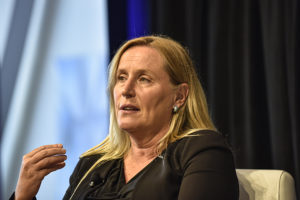How Gender Equality Can Be Built Into Your Business


What does the glass ceiling look like in 2019?
“We see more women at the entry level, but not as much diversity at the top,” said Iris Bohnet, behavioral economist and academic dean of the Harvard Kennedy School. “There is still unconscious bias.”
Bohnet spoke on gender equality with Nancy Gibbs, director of Harvard’s Shorenstein Center, at the From Day One conference on Sept. 18 in Boston. By unconscious bias, Bohnet described those social stereotypes we’re not even aware of, in which we associate certain groups with certain positions. It’s an insidious factor in holding women back from achieving full gender equality in businesses and other organizations.
“Seeing is believing,” Bohnet said, meaning that to overcome unconscious bias, humans need to see stereotype-breaking examples modeled in the world. For example, if we don’t see male nurses, we might assume nursing is a solely female profession.
“The bad news is that we are biased,” Bohnet said. The good news is that in addressing bias, and making smart changes, we can have a major impact on gender equality and inclusion, said Bohnet, author of What Works: Gender Equality by Design.

However, she said, diversity training is not the answer. "I have not found one single study suggesting that diversity training works," Bohnet told Gibbs.
Why not? “Think about healthy-eating awareness. It doesn’t mean you won’t eat ice cream,” Bonhet explained. “Good intentions don’t always mean people follow through. For some people, when they go through diversity training, people feel they checked the box, and there is some evidence that people are more sexist afterward.”
“We recognize that we all have these biases,” said Gibbs, the bestselling author of The Presidents Club. “And the good news is that research shows some things work fantastically well. What are they?”
In answering that question, Bohnet said her biggest message is: Don’t try to “debias mindsets, debias systems.”
For example, in the 1970s, the Boston Symphony Orchestra started auditioning people behind a curtain so the judges would be unable to determine if the musician was male or female.
“Debiasing systems means doing the morally right thing—leveling the playing ground—but this is also the economically smart thing to do,” she said. Why? Because you get the best talent.
She said blind evaluations work particularly well when an organization is looking for new talent.
“Are there problems blind evaluations don’t solve?” asked Gibbs.
Yes. Bohnet said they don’t address the problems of promotion, even those that factor in high performance.
“A year and a half ago, when I was in Stockholm, 97% of Nobel prizes went to men,” said Bohnet. “Every year I get asked to fill out the Nobel form [and suggest a recipient]. Sometimes, solving the problem means remaking a form, sometimes it requires a curtain.”
And so, she suggested remaking the Nobel form as a way to “debias the system.” Instead of asking for one nominee, Bohnet suggested that the Nobel Committee ask for three. If you ask for only one, everyone might suggest their favorite. But if you ask for three, the answer will allow people to think more about variety and diversity.
Bohnet said unstructured interviews, the standard sit-downs in which prospective employees chat with a potential employer, are not useful despite their long tradition in the working world.
“I would get rid of the unstructured interview, it is the worst tool to predict future success,” she said.
The interviewer might ask you to talk about things that have nothing to do with how well you can do the job.
“There is a lot of noise [in an unstructured interview] and a prospective employee might talk about what we are interested in,” she said.

For Bohnet, that is Switzerland and hiking. If both interviewer and interviewee have similar interests and hobbies, they may have a lot to talk about during the interview. This may animate the conversation, but have little to do with evaluating job aptitude.
As an alternative, Bohnet suggests moving to a structured interview, one that asks the same exact questions of all interviewees for a particular job.
What’s the best way to run a structured interview? Bohnet suggested that an interviewer prepare by thinking through the job’s requirements in terms of skills. Then build a list of questions from there.
She offered one final takeaway from the conversation: “People believe that just because we are women, the idea is that we might be less biased.” Not necessarily so, she said.
Jennifer Mattson is a journalist and writer. She is a former producer for CNN and National Public Radio. You can find her work online at The Atlantic, Salon, Psychology Today and USA Today
The From Day One Newsletter is a monthly roundup of articles, features, and editorials on innovative ways for companies to forge stronger relationships with their employees, customers, and communities.